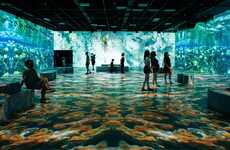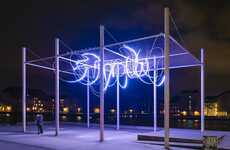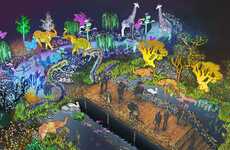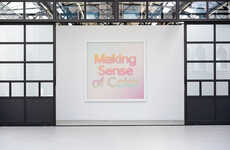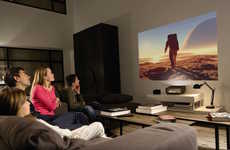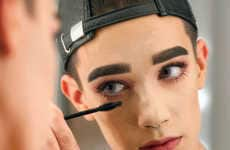
Trend Hunter Travels to Montréal for the 2016 Chromatic Festival
Katherine Pendrill — May 25, 2016 — Art & Design
This month, I had the privilege of traveling to Québec to visit the seventh Montréal edition of the Chromatic festival. Chromatic is an immersive art experience that brings together artists and festival-goers from a variety of creative industries to enjoy immersive exhibits that combine art and innovation. It is through these interactive activities that Chromatic aims to celebrate “the destruction of the hierarchy of the arts.” In addition to showcasing Montréal’s talent, this year the festival is also shining the spotlight on another creative city with a Toronto edition running from May 27th to May 28th.
VIA Rail Journey to Montréal
I started my trip by hopping aboard a special VIA Rail train car designed for Chromatic attendees. Playing on the theme of the festival, the vintage train car was given an artistic makeover by the talented Jason Botkin, Ola Volo and Jeremy Shantz. The artwork was completed in a mere four hours and it consisted of black and white decals representing each artist’s individual style. Despite the many different themes, the artwork blended together across the car to create a seamless design. To complement the hip murals, the train car was also outfitted with a full-service bar, an artist decorating Converse sneakers and a DJ that kept the music going for the entire trip.
After arriving in Montréal, I was whisked away to a dinner at Ê.a.t (Être Avec Toi), which is located within Hotel W. While dining with restaurant owner Peter Chase and MASSIVart's CEO Philippe Demers, I learned that Ê.a.t is far more than just a restaurant. Indeed, Ê.a.t blurs the boundaries between gallery and restaurant to turn the traditional dining experience into an artistic journey. As a result, the walls, tables, booths and even windows are covered in designs by local artists working with the creative agency MASSIVart. The restaurant thus serves as a unique reflection of Montréal culture in a way that is fully accessible to diners.
Day 1 of Chromatic PRO
After enjoying a lovely breakfast at Hôtel Le Germain, I headed off to Old Montréal to enjoy the first day of Chromatic PRO. Coproduced by MASSIVart and Phi Center, the conference brings together local and international professionals to discuss how to create value through art and culture.
The first session of the day was conducted by a number of influential cultural entrepreneurs, including Matthiew Debay, Félix Marzell and Adam Heard Rutledge. During the panel, each speaker discussed the concept of public art exhibitions as well as unique ways that artists can profit from the work they create.
This discussion was followed up by a case study exploring Moment Factory’s Foresta Lumina led by Catherine Turp. During her keynote, Turp explained how Moment Factory was able to turn a park in Québec into an immersive art experience. The case study demonstrated how the company can work with local tourist organizations and attractions to use art as an economic engine.
The first day rounded out with a panel discussing the different influences that drive Montreal’s creative leaders. This panel included insights from Philippe Meunier of Sid Lee, Valérie Lamontagne of Université Concordia and Stéphane Raymond of Moment Factory.
Day 2 of Chromatic PRO
My second day of Chromatic PRO involved more eye-opening presentations about how art can transform different cities and the value it adds to the community. These topics were discussed at length during a panel featuring Montréal real estate developer Natalie Voland, Jacquelyn West of Toronto’s Hermann & Audrey and Emily Bayliss of Austin’s SXSW festival. Each woman explained how their own work aims to integrate art into their community and some of the challenges they have faced executing their projects.
The second day of the conference rounded out with a discussion about selling art online between Étienne Morin Bordeleau of Art Bang Bang and Cale Fair of Nuvango. Both speakers discussed their approaches to selling art and how they work to make art more accessible by showcasing it in unique ways such as inside people’s homes or on specially designed clothing.
Chromatic Night
My experience at the Chromatic festival concluded with Nuit Chromatic #1, which was held at Hangar 16 on the city’s waterfront. The event was held inside a massive warehouse, where artwork was staged underneath the building’s high ceilings. While enjoying indie electro pop by a series of different DJs, I was able to enjoy a variety of large-scale multidisciplinary exhibits. These works included a cinematographic display by Guillaume Marmin, optical instruments by Camille Jodoineng and graffiti-inspired paintings by Luc-Antoine Chiasson. The experience ultimately allowed me to experience art in a hands-on way, thus solidifying the festival’s goal of allowing the public and artists to redefine art in their own way.
Photos by Beware Magazine & Stéphane Brugger
VIA Rail Journey to Montréal
I started my trip by hopping aboard a special VIA Rail train car designed for Chromatic attendees. Playing on the theme of the festival, the vintage train car was given an artistic makeover by the talented Jason Botkin, Ola Volo and Jeremy Shantz. The artwork was completed in a mere four hours and it consisted of black and white decals representing each artist’s individual style. Despite the many different themes, the artwork blended together across the car to create a seamless design. To complement the hip murals, the train car was also outfitted with a full-service bar, an artist decorating Converse sneakers and a DJ that kept the music going for the entire trip.
After arriving in Montréal, I was whisked away to a dinner at Ê.a.t (Être Avec Toi), which is located within Hotel W. While dining with restaurant owner Peter Chase and MASSIVart's CEO Philippe Demers, I learned that Ê.a.t is far more than just a restaurant. Indeed, Ê.a.t blurs the boundaries between gallery and restaurant to turn the traditional dining experience into an artistic journey. As a result, the walls, tables, booths and even windows are covered in designs by local artists working with the creative agency MASSIVart. The restaurant thus serves as a unique reflection of Montréal culture in a way that is fully accessible to diners.
Day 1 of Chromatic PRO
After enjoying a lovely breakfast at Hôtel Le Germain, I headed off to Old Montréal to enjoy the first day of Chromatic PRO. Coproduced by MASSIVart and Phi Center, the conference brings together local and international professionals to discuss how to create value through art and culture.
The first session of the day was conducted by a number of influential cultural entrepreneurs, including Matthiew Debay, Félix Marzell and Adam Heard Rutledge. During the panel, each speaker discussed the concept of public art exhibitions as well as unique ways that artists can profit from the work they create.
This discussion was followed up by a case study exploring Moment Factory’s Foresta Lumina led by Catherine Turp. During her keynote, Turp explained how Moment Factory was able to turn a park in Québec into an immersive art experience. The case study demonstrated how the company can work with local tourist organizations and attractions to use art as an economic engine.
The first day rounded out with a panel discussing the different influences that drive Montreal’s creative leaders. This panel included insights from Philippe Meunier of Sid Lee, Valérie Lamontagne of Université Concordia and Stéphane Raymond of Moment Factory.
Day 2 of Chromatic PRO
My second day of Chromatic PRO involved more eye-opening presentations about how art can transform different cities and the value it adds to the community. These topics were discussed at length during a panel featuring Montréal real estate developer Natalie Voland, Jacquelyn West of Toronto’s Hermann & Audrey and Emily Bayliss of Austin’s SXSW festival. Each woman explained how their own work aims to integrate art into their community and some of the challenges they have faced executing their projects.
The second day of the conference rounded out with a discussion about selling art online between Étienne Morin Bordeleau of Art Bang Bang and Cale Fair of Nuvango. Both speakers discussed their approaches to selling art and how they work to make art more accessible by showcasing it in unique ways such as inside people’s homes or on specially designed clothing.
Chromatic Night
My experience at the Chromatic festival concluded with Nuit Chromatic #1, which was held at Hangar 16 on the city’s waterfront. The event was held inside a massive warehouse, where artwork was staged underneath the building’s high ceilings. While enjoying indie electro pop by a series of different DJs, I was able to enjoy a variety of large-scale multidisciplinary exhibits. These works included a cinematographic display by Guillaume Marmin, optical instruments by Camille Jodoineng and graffiti-inspired paintings by Luc-Antoine Chiasson. The experience ultimately allowed me to experience art in a hands-on way, thus solidifying the festival’s goal of allowing the public and artists to redefine art in their own way.
Photos by Beware Magazine & Stéphane Brugger
Trend Themes
1. Immersive Art Experiences - Opportunity for artists and creative industries to collaborate and provide interactive and immersive art experiences that challenge traditional boundaries.
2. Integration of Art and Dining - Opportunity for restaurants to incorporate artistic elements into their dining spaces, blurring the lines between gallery and restaurant and providing diners with a unique artistic journey.
3. Art as Economic Engine - Opportunity for art organizations and attractions to use art as a means to drive economic growth in local communities and tourist destinations.
Industry Implications
1. Art Galleries - Art galleries can showcase immersive and interactive art experiences that offer a unique and transformative artistic journey for visitors.
2. Restaurants - Restaurants can blur the boundaries between dining and art by incorporating artistic elements into their spaces, providing a unique and immersive dining experience.
3. Tourism - Tourism organizations and attractions can collaborate with artists to create immersive art experiences that attract visitors and drive economic growth in local communities.
6.9
Score
Popularity
Activity
Freshness


